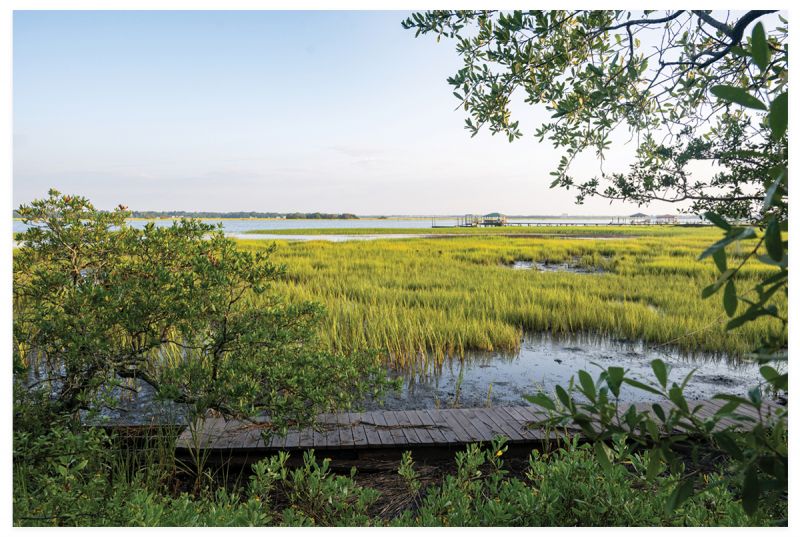Learn more about professionals and citizen scientists working knee-deep and sometimes head-high in our waterways

Salty or fresh, high or low, murky or clear; water in Charleston is indeed everywhere. Water caresses our beaches, laps up against the Battery, meanders through marshes and creeks, sumps into swamps, and—during king tides and epic rains—storms our streets. Water is Charleston’s ubiquitous element, our secret sauce and not-so secret threat. Living with water, as Dale Morris, Charleston’s former chief resilience officer (who, much to the chagrin and concern of many, resigned as this issue was going to press) says, is our 21st-century existential challenge. To that point, the City of Charleston expects to present its two-years-in-the-making, $1-million “Comprehensive, Integrated Water Plan” this summer, detailing the city’s flooding infrastructure and strategies to address sea-level rise.
The plan will be a data-driven continuation of the Dutch Dialogues process begun years ago and will likely articulate the choices and challenges the city faces given projections that Charleston’s sea level will rise another 14 inches by 2050. The engineers, city planners, and flooding experts across federal and state agencies who have developed that plan are far from the only people invested in helping us live responsibly, and happily, in our saturated landscape. The Lowcountry is fortunate to have a plethora of conservationists and creatives, activists and scientists, nonprofits and small businesses working to protect our waterways and marine habitats.
While the bureaucrats and policy wonks are tackling water issues from the top down, let’s meet a few of those on the ground, or rather, in our waterways, who are knee-deep, and sometimes head-high, in water work.

(Left to right) Two men wade at the corner of Meeting and South Battery streets after a 1940 hurricane turned White Point Garden into a waterway; The flooding of local roadways, whether from storms or king tides, is a regular hazard. NOAA’s Office for Coastal Management reports that nuisance flooding is more than twice as likely to occur as it was in 2000 and that rate could double or triple by 2030.
When thousands and thousands of plastic nurdles began washing up on Sullivan’s Island in 2019, Andrew Wunderley’s phone lit up. As Charleston’s Waterkeeper, the former lawyer-turned-aquatic activist is the first responder when pollution, spills, or other mishaps impact local waterways, and nurdles kept him and his team (then two staff plus thousands of volunteers) busy as the tiny, lentil-sized pellets kept turning up along waterfronts and creek banks across the region. “Plastic pollution is a huge issue for our waterways and marine life,” says Wunderley, whose organization joined the 2016 push for bans on single-use plastic bags. >>READ MORE
There’s a sly wink in the MARSH acronym, like the jovial twinkle you catch in Joel Caldwell, Blake Suárez, and Blake Scott’s eyes, even early in the morning after a late night at the rollicking RECESS event—a fundraiser during which local artists made art focused on ecology, stewardship, and community to benefit the group. These three dads, with six kids under age five between them, have been up with their wee ones for hours, but still they’re jazzed to talk about their “other child,” the scrappy nonprofit whose name stands for “Marsh Appreciation and Restoration Society for Happiness.” Yep, a mouthful, but a happy, smiley-face mouthful. >>READ MORE
“People think of us as a tourist destination, but our conservation and outreach work extends far beyond the aquarium walls,” says Sara McDonald, director of conservation for the South Carolina Aquarium. McDonald, a former manatee biologist with a PhD in marine science and conservation from Duke, came to Charleston via the Monterey Bay Aquarium, where her research was focused on the international seafood supply chain. “It’s hard to see results when working on complex international issues,” she says, “but what I loved about the opportunity here is that the work is community-based and on a smaller scale. After a day of planting cordgrass in a salt marsh, I can stand back and say, ‘We did that!’ We’re affecting real change.” >>READ MORE
That aforementioned, problematic flooding area, including the intersection of Line and Hagood streets, happens to be on the site of the Gadsden Green housing complex in the center of the Gadsden Green community, a historically African American neighborhood on Charleston’s Westside. Running through it, and the source of much of the flooding, Gadsden Creek was once a healthy, navigable tidal creek where residents fished and swam. It was part of the community’s livelihood and where many residents were baptized. >>READ MORE
Joshua Robinson goes with the flow—literally and professionally. A soft-spoken, deep thinker who grew up in the Lowcountry, he brings a native’s knowledge and love of waterways to his work as an environmental hydrologist and principal engineer of Robinson Design Engineers (RDE), the firm he founded in 2008. Today, what began as a solo enterprise has expanded to a team of seven, with offices in Charleston and Hendersonville, North Carolina. “We’ve been at the right place at the right time,” says Robinson, who has worked with Friends of Gadsden Creek, consulted with the City of Charleston on flooding and the Dutch Dialogues process, and partnered with numerous institutions and property owners. >>READ MORE